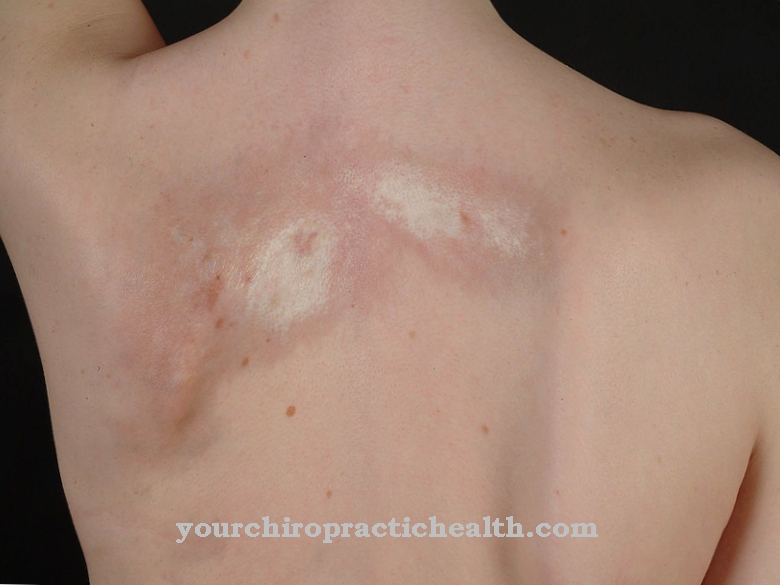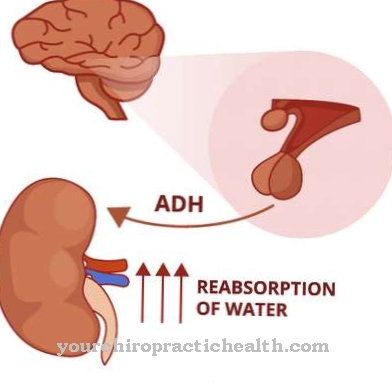Under the term Frozen shoulder or Stiff shoulder Doctors understand a disease in which there is significant restriction of movement and ultimately stiffening of the shoulder joint. The symptoms are due to inflammation in the shoulder capsule. Frozen shoulder is a self-limiting disease that heals on its own after a while.
What is a frozen shoulder?

© leungchopan - stock.adobe.com
The Frozen shoulder, also under the name Frozen shoulder (frozen shoulder) has been known since 1872. This independent clinical picture is an active and passive stiffening of the shoulder joint.
This is usually accompanied by severe pain. It usually affects men and women between the ages of 40 and 70, who often already suffer from a metabolic disorder such as diabetes. Frozen shoulder syndrome is also more common in heart and lung patients.
The frozen shoulder heals by itself after several years, but some sufferers have a movement deficit that cannot be reversed. So far, doctors have not been able to foresee how the disease will progress and how much the remaining restrictions will make themselves felt.
causes
Frozen shoulder syndrome occurs more frequently after traumatic causes, such as a broken bone in the shoulder area. After such an injury, the shoulder is usually spared for a period of several weeks or even months, and this leads to a frozen shoulder.
The same applies to diseases in the shoulder area, such as a rotator cuff tear, as well as to age-related shoulder wear. Infections that lead to pain and relieving posture can also cause Frozen Shoulders. In all of these cases, experts speak of secondary frozen shoulder because they are due to a previous injury or illness.
For most of those affected, however, it is instead a primary frozen shoulder for which no clear trigger can be identified. Sometimes this even occurs spontaneously.
Symptoms, ailments & signs
A so-called frozen shoulder is associated with clear symptoms, so that a self-diagnosis is quite possible. Many affected people complain of a dull pain that persists even when at rest. The entire range of motion of the shoulder is very limited, so that every movement is very painful.
The pain with a frozen shoulder does not start suddenly, but occurs much more slowly. At the beginning you only hear a slight tug in the shoulder area. After several days, the pain spreads throughout the shoulder, so that movement is significantly restricted. In particularly bad cases, reddening occurs, which can be seen directly in the shoulder area.
In many cases the skin is very warm at this point, which can be counteracted with permanent cooling. A frozen shoulder is accompanied by severe pain that can even spread to the arm. Anyone who refrains from treatment by a doctor at this point must expect a considerable worsening of the symptoms.
On the other hand, those who opt for treatment can quickly and effectively relieve the pain in the shoulder. Only those who opt for medical and drug treatment will be able to enjoy a full recovery.
Diagnosis & course
The diagnosis of Frozen Shoulders is very easy to make. Usually it is the person concerned who see a doctor because of the restricted movement and the pain. If no direct cause can be identified, the attending physician will have a comprehensive discussion with the patient and then initiate imaging procedures such as an ultrasound examination or an X-ray.
These provide information about possible damage that can cause the frozen shoulder. Magnetic resonance imaging can also be helpful. Frozen Shoulders Syndrome is a self-limiting disease and heals on its own after a certain time.
In many cases, movement restrictions of varying intensity remain after this, which can, under certain circumstances, significantly limit the life of the person concerned. How long it takes to heal and what consequential damage remains cannot yet be determined with the current state of research.
Complications
If a frozen shoulder remains untreated for a longer period of time, various complications such as shoulder osteoarthritis or relapses can arise. The chronic pain can lead to further incorrect posture and the resulting new problems. In addition, sleep disorders, irritability and fatigue often occur.
Basically, a frozen shoulder is associated with a decrease in general well-being and the quality of life of the person concerned. The restricted mobility often leads to a withdrawal from social life - emotional complaints such as depressive moods or inferiority complexes can result. Major complications are very rare in surgical interventions such as keyhole surgery.
Occasionally, infections, wound healing disorders, and vascular or nerve injuries can occur. Another possible deterioration in movement and residual stiffness is also possible. The side effects of pain relievers should also be considered. The preparations typically prescribed can cause symptoms such as gastrointestinal problems, headaches and skin irritations, among other things.
If there are other illnesses or if other drugs are taken, interactions can occur. Finally, the improper use of natural remedies can also cause problems. The same applies to procedures such as acupuncture, biofeedback or magnetic therapy.
When should you go to the doctor?
If your shoulder is frozen, you should always seek medical treatment. In most cases, this disease does not self-heal, so the person affected always needs medical treatment. A doctor should be consulted if there is very severe pain in the shoulders. This pain also occurs at rest and can also have a negative effect on the person's sleep.
The pain from the shoulders often spreads to the neighboring regions of the body and also leads to very severe complaints there. A doctor should also be consulted if there is restricted movement. Furthermore, a warm spot on the skin on the shoulders can indicate frozen shoulder and should be examined if it does not go away on its own.
Consult a doctor especially after an injury or an accident. An orthopedic surgeon or a general practitioner can be visited. In emergencies or severe injuries, an emergency doctor should be called or the hospital should be visited directly.
Treatment & Therapy
How successful the treatment of frozen shoulder is depends primarily on the underlying cause of the disease. The goal of therapy should always be to achieve a pain-free, complete range of motion for the shoulder.
In mild cases, for example after an injury, physiotherapy exercises help. These gradually expand the range of motion. The person affected can also do certain exercises at home and thus contribute to their healing. It is also possible to administer anti-inflammatory drugs. The administration of cortisone improves the condition of many patients. The drug can be administered in tablet form or as an injection.
If the shoulder stiffness persists, it may be necessary to move the joint under anesthesia. In so-called anesthesia mobilization, the patient is anesthetized and the shoulder joint is moved in all directions for several minutes. At this point, it is also possible to use arthroscopic tools to penetrate the joint and remove the inflamed synovial membrane.
This method ensures a reduction in pain and, through subsequent anesthesia mobilization, can also significantly increase the mobility of the shoulder. Which treatment method is used depends largely on the severity of the symptoms.
You can find your medication here
➔ Medicines for joint painprevention
Frozen shoulder can only be prevented to a limited extent, since in many cases it occurs spontaneously and without an obvious trigger. Secondary frozen shoulder, which has a clear cause, is also difficult to avoid.
However, it is possible to improve the condition and reduce the duration of the frozen shoulder syndrome by starting suitable physiotherapeutic measures as early as possible.
If symptoms such as a stiff shoulder or pain when moving the shoulder joint occur, it is advisable to consult a doctor. The doctor can make a diagnosis and, if necessary, initiate suitable therapy, which may prevent the disease from progressing.
Aftercare
Follow-up treatment of the frozen shoulder is necessary if it has to be treated surgically, which is usually done through an arthroscopy. The patient can be treated under inpatient conditions for around five days and is given a pain catheter, which enables almost painless physiotherapy exercises.
The physiotherapeutic follow-up treatment of the frozen shoulder begins immediately after the operation. Early therapy is considered urgent. A needs-based pain therapy is carried out beforehand. In addition, the patient performs both active and passive movement exercises under the guidance of a physiotherapist. With the help of a motorized movement rail, the affected shoulder can be moved three times a day for 30 minutes.
In most cases, inpatient therapy takes five to eight days. An orthopedic surgeon then takes care of the aftercare on an outpatient basis. In total, the physiotherapy treatment, which takes place according to a fixed schedule, lasts about three months. The patient's incapacity for work depends on the workload. As a rule, with a normal healing process, it is between three and six weeks.
Post-treatment of frozen shoulder is considered labor-intensive. The patient must also complete a special home program within their own four walls. He also needs a lot of patience. It can take up to six months before the treated shoulder can move freely again.
You can do that yourself
Patients who suffer from a "frozen shoulder" need above all else. Both the pain and the stiffness in the shoulder usually resolve on their own. But that can take months. During this time, patients can also help themselves to improve their condition.
After a sports injury or an accident, physiotherapy should be started in good time so that the shoulder does not become stiff in the first place. Even with a spontaneous frozen shoulder, for which the causes are often not known, physiotherapy exercises help to significantly accelerate recovery. In the beginning it is often necessary to take pain medication immediately before the physiotherapy session so that the measure remains bearable for the patient. For mild to moderate pain, over-the-counter drugs from the pharmacy are usually sufficient. After consulting the attending physician, a patient can also take this if the pain, which is often particularly severe in the resting position, prevents him from sleeping.
Compresses also help, with some patients responding better to warmth and others better to cold. Here the person concerned has to find out for himself which temperature situation has a favorable effect on him. With cold treatments, the compresses or the ice pack should only be applied for a short time, about 30 seconds to a minute. This often leads to an almost complete disappearance of the pain for several hours.






.jpg)




















